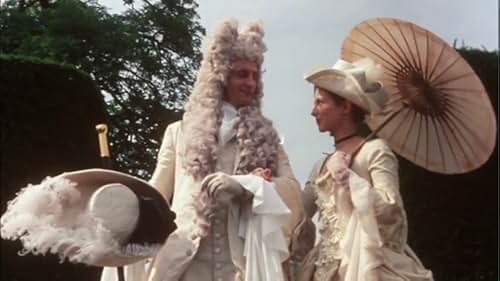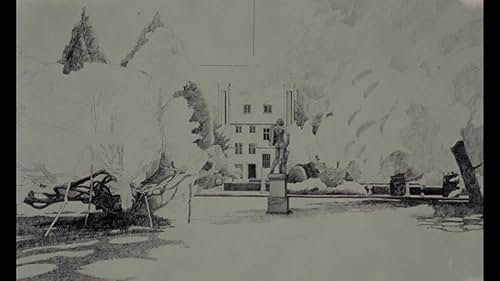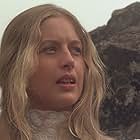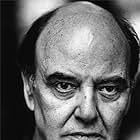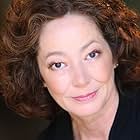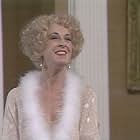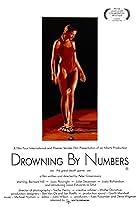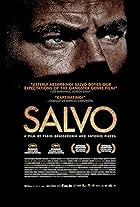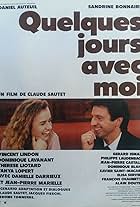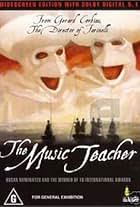A young artist is commissioned by the wife of a wealthy landowner to make a series of drawings of the estate while her husband is away.A young artist is commissioned by the wife of a wealthy landowner to make a series of drawings of the estate while her husband is away.A young artist is commissioned by the wife of a wealthy landowner to make a series of drawings of the estate while her husband is away.
- Awards
- 1 win & 4 nominations
Anne-Louise Lambert
- Mrs. Talmann
- (as Anne Louise Lambert)
- …
Nicholas Amer
- Mr. Parkes
- (as Nicolas Amer)
Lynda La Plante
- Mrs. Clement
- (as Lynda Marchal)
Alastair G. Cumming
- Philip
- (as Alastair Cumming)
- …
- Director
- Writer
- All cast & crew
- Production, box office & more at IMDbPro
Storyline
Did you know
- TriviaDirector Peter Greenaway, a former art student, created the sketches that feature in the film. In fact the close-up shots of the draughtsman drawing are of his hands.
- GoofsThe cooing of a collared dove is not a sound that would have fallen on Jacobean ears, as the species was unknown in Britain until 1955.
- Quotes
Mr. Neville: You must forgive my curiosity, madam, and open your knees.
- Alternate versionsWhen Peter Greenaway screened the movie at festivals in 1982, it ran a full three hours. Included in this footage is a full and further explained rationale for the moving statue.
Featured review
"I think my films are always quite self-reflexive and always question 'why am I doing this, is this the right way to do it, what is cinema for, does it have a purpose?"
I'm glad I could find that quote from the man responsible of that film that had me scratching my head for hours and whistling its infectiously catchy tune. Indeed, Peter Greenaway's "The Draughtsman's Contract", directed in 1982, is one of these films that defy analysis and can only be approached through sketches drawn on your own intuition's boards, I watched it three times in a row and I know now that a fourth time will do no good.
And so I figured "what the heck?"... maybe there are some movies that are deliberately unreachable because even the author would fail to be explicit without betraying his own vision. Though I know some would label that film as pretentious nonsense, Greenaway's quote is the perfect getaway: he doesn't aim at the viewers with his films, he doesn't even aim at himself, what he knows is that the film comes from his own inspiration and that's what matters, the rest belongs to cinema.
But I'm sure I would have joined the bandwagon of criticism if it wasn't for one thing the film gets right and that any viewer can agree with: its photogenic beauty. After all, this is a film set in 1695 and so the baroque style invites itself into the picture and we have these intimate shots embedded in stark contrasts like in Caravaggio's paintings, not to mention an orgy of costume designs and make-up combining the most grotesque extremes of the so-called civilized world.
Greenaway while delighting your eyes with such visual marvels also provides great landscape shots that for once, serve a purpose and aren't there to look pretty on the camera. And so we have the beauty and simplicity of geometry and the treacherous nature of the upper-class waltzing together under the triumphant music of Michael Nymar, inspired by Henry Purcell. To put it simply, this is a film that is beautiful to look at and listen to, but that shouldn't take away the bizarreness of the plot..
In fact, the opening prepares to it with many conversations about architecture, one about many streaks of reservoirs dug under an estate could foreshadow the web of intrigues, and it reminded me of the reputation of the Versailles Palace in France, which as beautiful as it was, couldn't cover the stink in the corridors, visitors satisfying their urgent needs in hidden corners. But I'm digressing, let's get back to the film.
The film centers on a landscaper Mr. Neville (Anthony Haggins) who's too arrogant not to be a real ace in his trade, and there are two aristocratic couples: Mr. And Mrs. Herbert (Dave Hill and Janet Suzman) and their daughter and son-in-law the Talmans (Anne-Louise Lambert and Hugh Fraser). Neville signs a contract with the mother (let's call her that way for the sake of clarity), he must produce twelve landscape drawings of her country house, gardens and outbuildings included. Then Nevill adds a clause that's so special I could only copy-paste it: to meet Mr. Neville in private and to comply with his requests concerning his pleasure with me."
O tempora, o mores... I guess. Anyway, the sequences showing the process of sketching are fantastic to watch and the music just brings that energy that seems to prepare you to something. And then there's the mystery with many needless details intruding in the drawings: empty boots, a ladder, anything that look too incongruous but whose presence seem to prepare for something. There is also an odd man disguised as a statue and who doesn't do anything but appear but he, too must be there for a purpose.
Meanwhile, interactions consist merely on the mother honoring her part of the contract (not that she takes pleasure out of it), and Neville making fun of her son-in-law. Needless to say that Neville makes many enemies during the journey and when they try to cancel the contract, he refuses and one thing leading to another, it's the daughter taking the mother's place (since she inherited from her mother the talent to get the wrong man).
There's a lot going on, inheritance problems, absence of children, everything building up to a murder that occurs at two thirds of the film. And when you think that Neville had the making of a suave villain, he becomes the victim of his own shenanigans and his cockiness ends up backfiring at him, making him learn the hart way that one can't be pompous too long and as they say in French, the man just farted higher than his own... bottom. And at that point I won't spoil the rest of the film.
What Greenaway tried to express in his exhilaration of art and through its parallel with the things of flesh, a quest for pleasure within the work or maybe how an artist is immediately an outcast in his world. There's also a strange combination between the rigorism of his work and they way he lets loose details interfere with it, as if by lowering his guard that little, he would cause his own demise.
Anyway, I learned to lower my guard a little too and not expect to get a film, I'm sure there is a riddle in the film that wouldn't be solved even after ten times of viewing but I guess this is the kind of movies that tells pretty much something about the artist as much as it does about the art, and when he doesn't tell, it shows.
One valid and simple criticism, maybe Greenaway got carried away with the lighting and the wigs that he made it difficult to figure who's who (even the mother and daughter looked like they could be sisters).
I'm glad I could find that quote from the man responsible of that film that had me scratching my head for hours and whistling its infectiously catchy tune. Indeed, Peter Greenaway's "The Draughtsman's Contract", directed in 1982, is one of these films that defy analysis and can only be approached through sketches drawn on your own intuition's boards, I watched it three times in a row and I know now that a fourth time will do no good.
And so I figured "what the heck?"... maybe there are some movies that are deliberately unreachable because even the author would fail to be explicit without betraying his own vision. Though I know some would label that film as pretentious nonsense, Greenaway's quote is the perfect getaway: he doesn't aim at the viewers with his films, he doesn't even aim at himself, what he knows is that the film comes from his own inspiration and that's what matters, the rest belongs to cinema.
But I'm sure I would have joined the bandwagon of criticism if it wasn't for one thing the film gets right and that any viewer can agree with: its photogenic beauty. After all, this is a film set in 1695 and so the baroque style invites itself into the picture and we have these intimate shots embedded in stark contrasts like in Caravaggio's paintings, not to mention an orgy of costume designs and make-up combining the most grotesque extremes of the so-called civilized world.
Greenaway while delighting your eyes with such visual marvels also provides great landscape shots that for once, serve a purpose and aren't there to look pretty on the camera. And so we have the beauty and simplicity of geometry and the treacherous nature of the upper-class waltzing together under the triumphant music of Michael Nymar, inspired by Henry Purcell. To put it simply, this is a film that is beautiful to look at and listen to, but that shouldn't take away the bizarreness of the plot..
In fact, the opening prepares to it with many conversations about architecture, one about many streaks of reservoirs dug under an estate could foreshadow the web of intrigues, and it reminded me of the reputation of the Versailles Palace in France, which as beautiful as it was, couldn't cover the stink in the corridors, visitors satisfying their urgent needs in hidden corners. But I'm digressing, let's get back to the film.
The film centers on a landscaper Mr. Neville (Anthony Haggins) who's too arrogant not to be a real ace in his trade, and there are two aristocratic couples: Mr. And Mrs. Herbert (Dave Hill and Janet Suzman) and their daughter and son-in-law the Talmans (Anne-Louise Lambert and Hugh Fraser). Neville signs a contract with the mother (let's call her that way for the sake of clarity), he must produce twelve landscape drawings of her country house, gardens and outbuildings included. Then Nevill adds a clause that's so special I could only copy-paste it: to meet Mr. Neville in private and to comply with his requests concerning his pleasure with me."
O tempora, o mores... I guess. Anyway, the sequences showing the process of sketching are fantastic to watch and the music just brings that energy that seems to prepare you to something. And then there's the mystery with many needless details intruding in the drawings: empty boots, a ladder, anything that look too incongruous but whose presence seem to prepare for something. There is also an odd man disguised as a statue and who doesn't do anything but appear but he, too must be there for a purpose.
Meanwhile, interactions consist merely on the mother honoring her part of the contract (not that she takes pleasure out of it), and Neville making fun of her son-in-law. Needless to say that Neville makes many enemies during the journey and when they try to cancel the contract, he refuses and one thing leading to another, it's the daughter taking the mother's place (since she inherited from her mother the talent to get the wrong man).
There's a lot going on, inheritance problems, absence of children, everything building up to a murder that occurs at two thirds of the film. And when you think that Neville had the making of a suave villain, he becomes the victim of his own shenanigans and his cockiness ends up backfiring at him, making him learn the hart way that one can't be pompous too long and as they say in French, the man just farted higher than his own... bottom. And at that point I won't spoil the rest of the film.
What Greenaway tried to express in his exhilaration of art and through its parallel with the things of flesh, a quest for pleasure within the work or maybe how an artist is immediately an outcast in his world. There's also a strange combination between the rigorism of his work and they way he lets loose details interfere with it, as if by lowering his guard that little, he would cause his own demise.
Anyway, I learned to lower my guard a little too and not expect to get a film, I'm sure there is a riddle in the film that wouldn't be solved even after ten times of viewing but I guess this is the kind of movies that tells pretty much something about the artist as much as it does about the art, and when he doesn't tell, it shows.
One valid and simple criticism, maybe Greenaway got carried away with the lighting and the wigs that he made it difficult to figure who's who (even the mother and daughter looked like they could be sisters).
- ElMaruecan82
- Nov 29, 2021
- Permalink
- How long is The Draughtsman's Contract?Powered by Alexa
Details
- Release date
- Country of origin
- Languages
- Also known as
- Der Kontrakt des Zeichners
- Filming locations
- Groombridge Place, Groombridge, Kent, England, UK(country house)
- Production companies
- See more company credits at IMDbPro
Box office
- Budget
- £320,000 (estimated)
- Gross US & Canada
- $2,256,246
- Gross worldwide
- $2,283,233
Contribute to this page
Suggest an edit or add missing content

Top Gap
By what name was The Draughtsman's Contract (1982) officially released in Canada in French?
Answer
